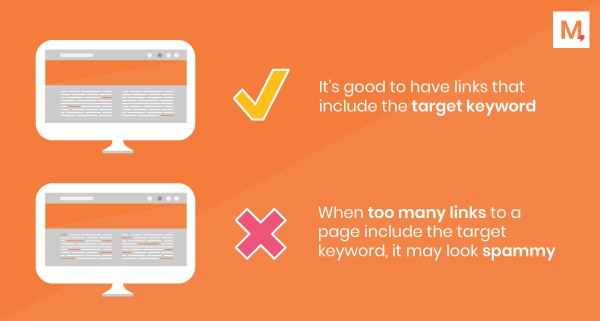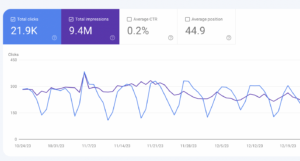Anchor text. You’ve probably heard of it but may not know exactly what it is or if you are using it properly. You’ve come to the right place to learn more about it!
We’re going to explain what anchor text is, how to best use it, and why it matters for SEO. Let’s jump in.
What Exactly is Anchor Text?
Anchor text, also called link text, is the clickable text on a page that is usually blue and underlined. It can also be bolded, not underlined, or a different color such as Markitors’ signature green.

The point of anchor text is to explain why there’s a link in the text and to inform a reader of what page they will land on if they click the link.
Here is an anchor text example: shameless plug here : )
In this instance, “SEO agency” is the anchor text used to link to Markitors’ home page because we as a company are an SEO agency. It’s significant to note that using the keyword “SEO agency” as the link text is strategic because it will affect our website’s rank for that specific keyword. You’ll want to be scarce with how often you do this when linking to external pages (external links), but it’s completely reasonable to do this quite consistently linking to pages on your site (internal links).
Anchor text is also an important component of a backlink. Backlinks are when another website links to a page on your site. This usually happens in one of two ways:
- Websites can directly drop the URL to your site or page using just the URL. For example:
- Markitors offer Digital PR Services for their small business clients. If you want to find out more information about those services, feel free to click the following link: https://markitors.com/digital-pr-services/
- Alternatively, websites can link to your site or page with a link inside of an anchor text. For example:
- Markitors offer Digital PR Services for their small business clients. If you want to find out more information about those services, feel free to click the link.
Both backlink anchor texts are viable options. Nonetheless, the second example has greater SEO implications that we will talk about later.
Orbit Media explains anchor text and backlinks perfectly and why they matter:
“When another website links to one of your pages, it’s a vote of confidence. It’s an indication of relevance, and Google notices.”
This graphic shows what happens when you optimize anchor text and how it can be beneficial or detrimental to your website’s SEO.

Where is Anchor Text Used?
Now that you know what anchor text is, let’s jump into where it is used.
Anchor Text for Internal Links
Internal linking is super important for SEO for a number of reasons. For one, it sends signals to Google about how the pages on your site are interconnected.
When using internal links, only add links that are truly relevant to the content and valuable to your reader. Don’t add internal links just to have them; they should be deliberate and intentional. Every time you link to an internal page on your site, you are welcoming the potential to send users to that page.
Anchor text for internal links should be straightforward to help guide your reader through different pages of your website.
Anchor Text for External Links
Anchor text for external linking is also very important. By using descriptive and SEO link text, you are essentially telling Google, “Hey Google, just so you know, I trust this page about subject X (being whatever the anchor text specifies).”
You trust the page as something to recommend to your readers because you know it will be valuable to them.
In other words, every time you link to an external website’s page on your site, you are opening up a door to that site. So whenever you link to a website using a specific anchor text, remember that you are vouching for that site to your users and Google.
What Makes an Anchor Text Optimized?
Using optimized anchor texts sends a signal to Google that says, “This page is a resource on this topic.” Since every topic can be boiled down to a keyword, an anchor text is most closely associated with a keyword (whether short-tail or long-tail).
Take the “SEO agency” link text from earlier as an example. The anchor text is optimized because it is focused on a keyword that we represent as a company and would like to rank for on Google.
Overdoing this is not recommended. That’s because doing so actually goes against Google’s best practices. More on this below as we share the risks of aggressively using SEO-optimized anchor texts.
Should You Use SEO Anchor Texts?
The quick answer is yes! But, there are some things you absolutely need to be careful about (we will get into that later). Optimization is effective if done correctly.
Types of Anchor Texts
There are different types of anchor texts that serve different purposes. Some anchor texts focus on brand credibility while others are editorially driven.
Branded Anchor Text
When you use your brand’s name such as Markitors as your anchor text.
Naked Anchor Text
For naked anchor text, you simply hyperlink the URL of the site like this www.markitors.com.
Generic Anchor Text
When you use something like click here as an anchor text, it is considered generic. This is fine every once and a while, but it doesn’t benefit you, Google, or the user (especially for accessibility purposes).
Image Anchor Text
Google uses the ALT tag of an image as its anchor text.
<img src=”img_girl.jpg” alt=”marketing agency” width=”500″ height=”600″>
Latent Semantic Indexing (LSI) Anchor Text
An LSI is simply using a relevant keyword to the page like this, SEO agency.
Partial Match Anchor Text
A partial match anchor text matches the target keyword partially such as learn more about SEO for small businesses.
Exact Match Anchor Text
Exact match anchor text is when you use the exact keyword you want to rank for as link text such as Core Web Vitals.
Title Anchor Text
Title anchor text is exactly what it sounds like: using the title of the article you’re linking to as the anchor text. An example would be, to learn more, check out How to Get Google to Index My Site.
Co-occurrence
Co-occurrence is placing a target keyword close to your anchor text. It is an effective alternative to exact match anchor text because it sends the signal to Google that the keyword and the link are related.
Example
Target Keyword: SEO agency
Anchor text: visit this page
To read more information about our SEO agency, visit this page.
Anchor Text Distribution
According to Nathan Gotch of Gotch SEO on Youtube, the best practice for anchor text distribution is to follow this ratio when choosing link text and practicing co-occurrence.
Branded = 70% +
Naked = 20% +
Generic = 5% +
LSI, Partial Match, Titles = 1-5%
Exact Match = less than 1%
Risks of Using SEO-Optimized Anchor Texts
We want to be clear that there are known risks with using SEO anchor text — this is why we recommend if you do use it, use it intelligently, naturally, and sparingly.
Overdoing the optimization of anchor texts for SEO purposes violates Google’s Webmaster Guidelines. If you overdo optimization, Google may assume you may be conducting a link scheme. (Oh, no!)
Link schemes are a no-go.
Google defines link schemes as
“Any links intended to manipulate Page Rank or a site’s ranking in Google search results may be considered part of a link scheme and a violation of Google’s Webmaster Guidelines. This includes any behavior that manipulates links to your site or outgoing links from your site.” (source: Google)
Basically, a link scheme is when you abuse optimized anchor texts and no longer serve the best interest of the user (to Google, the user is king). If you only use SEO link text, then you send a signal to Google that says, “I am trying to beat the system.”
Avoid over-using optimized anchor text for both your internal and external links. This will make you look suspicious and untrustworthy to Google bots. Refer to the link text distribution ratios as a guide to avoiding any penalty; however, it is just a benchmark, not a guarantee.
So, using SEO anchor text is a generally beneficial strategy, but we want to be explicit that you have to be careful to avoid link schemes, vary the use of the different types of anchor texts, and think about what signals you are sending to Google.
Conclusion
Are you feeling like an expert on anchor text? Good!
Remember, you can only try your best and you don’t always have control over what others do when linking to your website. But, lucky for you, you can control the links and anchor text you provide on your own website.
Have faith in the Google bots to crawl properly if you are implementing anchor text naturally, and you should be good to go.







